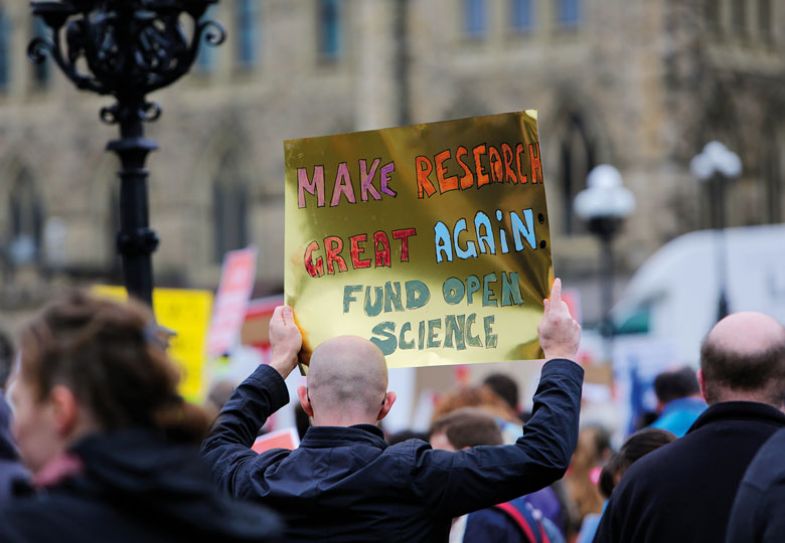Now that it has happened several times, Laurel Schafer fears that she is seeing the early signs of a sea change in international perspectives on Canada’s research prowess.
In three recent cases, the professor of chemistry at the University of British Columbia (UBC) has seen foreign students turn down offers to stay in Canada for doctoral work, preferring to pursue their studies south of the border. The students admitted that they were using Canada as a way station – remaining just long enough to gain permanent residency status before moving to the US.
“Quickly, we’re losing ground,” Schafer says. “Canadian research is at a moment in time when our ability to continue to play with world leaders is being – or has the potential to be – dramatically compromised.”
It was not supposed to be this way. When Justin Trudeau won Canada’s 2015 general election, academics celebrated the end of years of government hostility to science under his Conservative predecessor, Stephen Harper. But after a significant early funding boost, a series of unexpectedly lean federal budgets has raised anxieties about a national research enterprise marked by some weak underpinnings. And while Donald Trump’s Harper-style hostility to science and internationalisation gave Canada a comparative advantage during his presidency, Joe Biden’s election has turned the tables once again.
“Up until very recently, academic research in Canada was comparatively very well endowed. Things were going well, and the US was going to hell in a handbasket,” reflects Dan Breznitz, professor of innovation studies at the University of Toronto, who has just finished an 18-month posting in Canada’s Department of Finance. “But then suddenly, things changed.”
The Harper decade, between 2006 and 2015, was marked by funding cuts of nearly 8 per cent imposed on Canada’s three research councils, known collectively as the tri-council agencies, as well as a perceived overemphasis on commercialisation and restrictions on what government scientists could say in public. Researchers’ dismay was so deep that, in 2012, they staged a mock funeral in Ottawa to mourn the “death of evidence” in government, and Trudeau’s pledge to redress the situation was considered to be one factor in his landslide election victory.
But Trudeau’s election did not entirely silence the grumbles. Canada’s 2018 budget included a large increase in research and science funding over the following five years, including C$925 million (£554 million) for the tri-council agencies, plus C$275 million for “international, interdisciplinary, fast-breaking and higher-risk research”, amounting to an overall 25 per cent hike. This was “the single largest investment in fundamental research in Canadian history”, according to the budget document, but it was little more than half the amount recommended in a Trudeau-commissioned report by David Naylor, professor of medicine at the University of Toronto, which recommended that funding for basic research rise by more than a third within four years. And the delayed publication of Naylor’s report until after a 2017 budget that delivered no significant funding increases for science created suspicion and bad feeling, prompting researchers to mount a #SupportTheReport campaign.
The value of those funding increases, moreover, has by now been whittled away by inflation, and there is among Canadian researchers a growing sense of policy drift. Given the “largely hostile Conservative government, just putting a friendly face to the scientific community seemed [to Trudeau] to be enough”, says Creso Sá, a professor of science policy, higher education and innovation at the University of Toronto. But he believes the government “doesn’t really have a plan when it comes down to solid implementation”.
Other than the early funding hike, Sá says, the administration’s achievements on science have been limited to such largely symbolic tactics as appointing a chief science adviser, announcing a few small initiatives and appointing study commissions whose advice it does not embrace.
An example is the expert advisory panel convened last autumn to advise the government on scientific research strategy, whose report, published in March, recommended substantially more funding. Yet Trudeau had not asked the panel, led by Frédéric Bouchard, dean of arts and sciences at the University of Montreal, for advice on funding, and his government’s latest budget, delivered in the same week the report was published, offered no more money for the tri-council agencies or for the younger generation of Canadian scientists, such as those being lost by Schafer and UBC.
There is, to be fair, some hope that more money will arrive eventually, as it did in response to the Naylor report. The government has signalled a willingness to raise spending at the tri-council agencies either next year or as a mid-term adjustment to the federal budget later this year, and university officials believe that the government – and especially François-Philippe Champagne, the minister of innovation, science and industry – clearly understands the danger from flatlining budgets.
“He’s feeling the heat, and we’re encouraged by that,” says Paul Davidson, president and chief executive officer of Universities Canada, the nation’s chief higher education association.
Macroeconomic figures appear to bear out academics’ concerns. Canada spent only 1.6 per cent of its gross domestic product on research in 2019, down from 2 per cent in 2000 and well below the 2.7 per cent average among members of the Organisation for Economic Cooperation and Development (OECD). That is “a terrible number”, says Jeremy Kerr, a professor and chair of biology at the University of Ottawa and co-author of a 2017 critique of Canada’s national research strategy commissioned by the Global Young Academy, an international society of early-career scientists.
In addition, Canada has dropped from above average to average on the OECD’s measure of researchers per size of population. The country has fallen in recent years on the Bloomberg list of most innovative nations, and last year the OECD predicted that Canada’s would be the worst performing of 38 advanced economies over the next 40 years.

“And Canada”, Breznitz sniffs, “thinks it’s a real G7 economy.”
Canada’s approach to research has been shaped – stunted, some suggest – by several factors. One is its historic natural wealth in minerals, timber and fossil fuels, which has reduced the need to develop more cutting-edge sectors. That prevalence of relatively low-tech industry is reflected in Canada’s low spending on private research and development.
“The overall picture of [corporate] research and development in Canada is horrific, and has been going down for 21 years, and I don’t see it stopping any time soon,” Breznitz says, citing OECD figures on business R&D expenditure as a proportion of GDP.
Another factor is the protections that the government affords some of its major industries, such as telecommunications and banking, which critics allege stifle innovation. And a third is the nation’s proximity to the US, which creates strong incentives for private firms to pursue product development in that much larger marketplace.
But with fewer than 40 million people, Canada manages to rank ninth globally by per-capita wealth. And with so much still working well, Canadians have trouble absorbing any indicators or warnings that they may actually be facing real danger. Bouchard, the expert panel chair, sees that dynamic first-hand as he works in Montreal alongside one of the world’s top experts in artificial intelligence, Yoshua Bengio. “We’re very good, and in some sense, we’re comfortable with that,” Bouchard says. “And I think it’s a grave mistake.”
As for the US factor, even as the Trump administration sent all the wrong signals to scientists at home and abroad, the country never abandoned its basic science investments, and under Biden, it has pumped billions into applied ventures, led by a $50 billion ($40.3 billion) boost to its computer chip development and manufacturing efforts. Seemingly in response, Universities Canada’s Davidson says, the Trudeau administration invested C$13 billion – some eight times the annual budget of the Natural Sciences and Engineering Research Council – to attract a single Volkswagen electric vehicle battery production plant.

More fundamentally, the government is moving in the direction of trying to pick industries that it deems worthy of research investment and directing resources towards supportive academic partnerships. Yet, even there, Trudeau’s policy has seemed uncertain.
In his administration’s early years, the Canada Research Coordinating Committee was formed to more closely unite the work of the tri-council agencies. Then, early last year, Canada followed the UK in announcing that it would establish its own version of Darpa, the legendary US agency that invests large amounts of funding on speculative leaps at potentially valuable technologies. More recently, however, Canada has abandoned the Darpa idea in favour of a somewhat more conventional agency for uniting academic science and business innovation called the Canada Innovation Corporation, modelled on existing agencies in Israel and Finland. And now the Bouchard panel has suggested yet another entity, the Canadian Knowledge and Science Foundation, which would add new layers to the academia-business translational pathway by taking on such duties as government-wide strategic planning and the coordination of global partnerships.
The details are still being sorted out, but Canadian policymakers appear to have embraced the idea that strong business-sector partnering is necessary and urgent for universities. This has resurrected Harper-era fears of the commercialisation agenda overshadowing the critical need to keep basic science funded at a healthy level. Canada became a leader in AI, telecommunications and electric car batteries, Davidson says, only because of investments in blue-sky research made by governments a generation or more ago. “Right now, the government is eating its own seed corn,” he says.
Yet it is open to question whether the Canadian public would support substantial increases in discovery-driven science when the country’s universities and economy appear to be doing well and other social priorities seem more pressing.
Healthcare stands as a major example. While the US spends far more on biomedical research than Canada does, the latter is among the many developed nations that offer a form of universal healthcare. It’s reasonable to suggest, Kerr says, that Canada might be making the better choice for its people by emphasising medical care over medical science.
Another example is the lack of safe drinking water available to Canada’s Indigenous communities. “So the question is: do you want to improve research a little bit, or do you want to make sure that there’s drinkable clean water on reserves,” Kerr says. “And you have to come up with a coherent reason why the one or the other is the better priority. If you just ask people, without giving them all kinds of background information, they’re going to say, ‘Well, maybe let’s do drinking water, and we’ll worry about the details of other things later.’”
That array of choices is reflected in the Trudeau administration’s attitude towards academic research, says Jim Woodgett, a professor of medical biophysics at the University of Toronto. “Clearly it’s not one of the top five, or maybe even top 10, in their priorities,” he says. “Sometimes science doesn’t give you an obvious return on investment. That’s a hard sell to government.”
A separate set of difficult questions surrounds the fate of Canada’s youngest scientists and the recognition of their importance to the country’s future. Canada has put a huge emphasis on attracting students from abroad, offering promises that graduates can stay and pursue careers in the country. But it may be losing them just as quickly because of its underinvestment in their educational and employment prospects.
While many graduate-level researchers in the US and Europe earn actual salaries, those in Canada are “just basically scraping money from everywhere”, says Catherine Beaudry, a professor of mathematics and industrial engineering at Polytechnique Montréal. “We’re not competitive at all” in the fight for the next generation of scientists, she says.

One issue is that early-career stipends have scarcely risen in absolute terms over the past 20 years.
“They expect a master’s student to live on C$17,500 (£10,000) a year,” says Richard Cannings, a biologist who taught at UBC and has served since 2015 in the federal parliament as a member of the New Democratic Party. “And you can’t do that.”
Federal data does not register an early-career brain drain just yet. But Schafer, a co-author of the Bouchard report, is not alone in seeing disturbing signs. Bouchard himself describes the difficulties of pursuing top doctoral students who understand that the pay and laboratory resources are often better in the US. To improve things, “we’re not talking about bringing graduate students into luxury”, he says. “We’re talking about giving students a respectable living wage.”
According to Woodgett, “the scientific community needs to do a much better job of making a compelling case to say why Canada has to move away from just pulling things out of the ground”. Rather than betting its future on endless resource extraction, the government needs to be convinced of the need to develop “more sophisticated products and discoveries, which can then be commercialised to create new industries”.
He worries, however, that academic scientists might be getting so frustrated with the grim familiarity of their funding situation that they are forgetting to voice the basic niceties that political leaders still want to hear. “There are people in government who listen. But they also don’t want to hear the same thing over and over again: ‘Just give us more money,’” Woodgett says. “That’s not good enough.”
Kerr’s assessment is even harsher. “Researchers always have their hands out for more money, but either forget to say thank you, or say that sort-of half-hearted thank you, like, ‘We asked for more, but I guess we'll say yes to this,’” he says.
More than the university research community might yet realise, Kerr says, that dynamic could explain why the Trudeau administration strikes them as only a modest improvement over the Harper government despite the big funding boost it delivered.
“The government did something wonderful for Canadian research, and researchers responded by spitting on the hand that fed them,” he says.
Schafer, for her part, “voted with enthusiasm” for Trudeau’s Liberal Party in 2015 but has spent her time since then writing to its ministers making clear “that this was not the government that I thought I voted for”. But she concedes that scientists have not done a good enough job of explaining to the Canadian public how fundamental research leads over time to economic benefit: “One could point fingers to us, as scientists, for not doing ourselves any favours.”
From his perch inside the government, Cannings believes that addressing funding problems is sometimes as simple as politely pointing out a potential oversight. One personal example for him is the Polar Continental Shelf Program, which supports Arctic research. Its funding had been flat for at least 15 years before he mentioned that fact to Trudeau officials.
“Nobody knew that it hadn’t gone up except the researchers, who were just kind of grumbling,” Cannings says. “One of them happened to be my brother, and he brought that up to me, and I brought it up to the minister, and lo and behold, it was fixed a few months later.”
As well as ingratitude, scientists also need to avoid overstatement, Kerr says. “It’s not like there’s going to be an abrupt catastrophe if research funding continues to erode at a slow pace,” he says. “No one’s going to argue Canada is a terrible place to live – the problem is that Canada is a wonderful place to live, and that makes it very easy to be complacent.”
Canada’s universities already are seen by some experts as guilty of exaggeration, having secured Trudeau’s initial funding boost by promising it would lead fairly directly to clear economic gains. That’s not the way investments in basic science work, Toronto’s Breznitz notes. Canadians, “rightly so, stopped believing their universities can change the economy after the universities promised and didn’t deliver. That was a horrible strategic mistake,” he says – all the more so because it altered public perceptions about the social purpose of universities. “Now most Canadians forgot that universities are more than just start-up factories,” he says.
The interaction between academic science and national economic success is tricky to understand and explain even for those who are deeply involved in it, Schafer says. But some of the public indifference about funding academic science seems attributable to published analyses that identified examples of companies in such places as the US, Germany and Brazil capitalising commercially on Canadian research.
“So there’s a concern that Canadian dollars are going in to develop these technologies but are not actually being taken up by Canadian companies to realise the full economic benefit to Canada,” Schafer says. Yet the government’s strategic response – to try choosing fields and technologies that the nation can best exploit – probably is not going to work either, she adds.
“If they had their way”, ministers would “try to steer us all to work on very selective problems that they believe Canadians are already leaders at and have the potential to stay at the forefront of”, she explains. “But academia doesn’t work that way, of course. We have to have training across the disciplines and then, at the end, we can finally build towards very specific and targeted emphases.”
Even the Covid pandemic may have cut both ways on the question of research benefit, giving the Canadian public some clear examples of it but perhaps also reinforcing unrealistic expectations about rapid timetables and guaranteed returns.
The first therapeutic for Covid that was approved by the US Food and Drug Administration was developed by Carl Hansen, a longtime professor of physics and astronomy at UBC, and his spin-off company, AbCellera. And Pieter Cullis, a professor of biochemistry at UBC, was central to the research that developed lipid nanoparticles, an essential element of the new class of mRNA vaccines used to stop Covid, such as the Moderna and Pfizer-BioNTech vaccines.
Those successes “made a big impression in Canada”, says Elicia Maine, a professor of innovation and entrepreneurship at Simon Fraser University. “By doing more use-inspired basic research, as well as applied research, and by clearly articulating how the universities are impacting and advancing issues that are creating social and economic value for Canada – that is clearly going to increase the support of a broader range of Canadians for more investment in research and higher education.”
Many others, though, are deeply sceptical of the idea that the government can reliably orchestrate such successes by pairing academia with industry. “There is zero evidence that partnering has ever worked to generate FDA-approved drugs, for example,” says John Bergeron, a professor of medicine at McGill University who studies research policy. Yet Canadian universities might better capitalise on policymakers who insist on a corporate-focused research strategy, Bergeron says, by finding ways of taking product-oriented grant money and deploying it in ways that help their research teams survive until the government provides more robust level of basic-science investments.
In the meantime, Bouchard says, Canadian universities and their researchers are likely to be left to wait and wonder if the “urgency” of increasing research funding is “understood at the highest level” of their government.
Naylor, the author of the 2017 report, has a similar outlook. “The federal government is playing with fire here,” he says. If the Trudeau administration does not address the shortfalls in basic science and researcher support within the coming year, the country could experience “a massive backlash and an exodus of talent”, he predicts.
“Every month you wait is a lost opportunity,” Davidson agrees. But he also sees a silver lining in the government’s lack of response.
“In a funny way, the fact that the government did nothing in this budget has been helpful,” he says. “It has galvanised not only the universities but civil society, the business community and others, to say, ‘Wait a minute – research is a strength of our country, and we’ve got to support this system.’”
Register to continue
Why register?
- Registration is free and only takes a moment
- Once registered, you can read 3 articles a month
- Sign up for our newsletter
Subscribe
Or subscribe for unlimited access to:
- Unlimited access to news, views, insights & reviews
- Digital editions
- Digital access to THE’s university and college rankings analysis
Already registered or a current subscriber? Login








